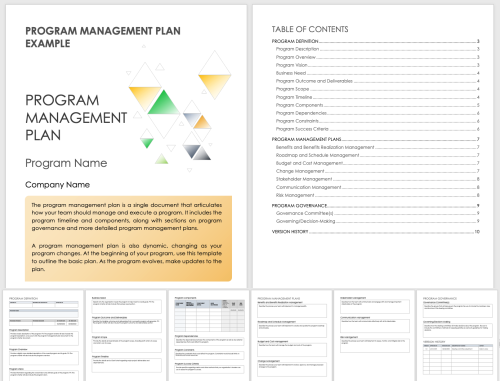
Team leaders must create a solid program management plan to successfully manage a program. We’ve gathered advice and tips from experts on how to create an effective plan, including what you need and the steps to take.
A program management plan details how a company expects to manage and execute a program. The plan features a program overview, along with details on the program scope and the strategy to move forward.
A program management plan will have similarities to and variations from a project management plan. Those differences will reflect some of the differences between project management and program management.
The purpose of a program management plan is to set out the structure and details of successfully executing a program. It will also describe how program leaders can make changes in the plan when needed.

“When I think about a program management plan, it's a strategic roadmap that documents everything that you need to be able to do to run a program,” says Jeff Givens, Senior Vice President of Operations at JDA TSG, a business process outsourcing firm. “That's timelines, milestones, responsibilities, deadlines, and future expectations.”
A good program management plan is vital to executing and managing a program effectively. You can learn more about best practices in managing a program in this guide.
A program manager leads the work on the program management plan. They gather input from the program sponsor, senior leadership, and program team members.
The program manager will prepare the preliminary draft of the plan and refer to the program charter and any business case and business analysis research the organization did for the program. The program manager will also include information on the program budget, scope, and benefits. Once they complete this work, they will share the draft with sponsors, company leaders, and others for their final input and approval.
Learn more about the responsibilities of a program manager and what it takes to be successful.
Components of a program management plan might vary based on needs. But almost all program management plans share common elements. These include details on goals and deliverables, responsibilities, and program governance.
A program management plan’s components will offer program details and provide a guide to move it forward. Here are some common components:

Givens describes what the plan must set out: “Who is going to be responsible and accountable?” He adds that program managers and teams will often use what’s called a RACI chart (which stands for responsible, accountable, consulted, or informed) to provide details on how various people or groups will be involved with or kept informed of certain tasks.
“Timelines are always going to be there, along with adjustable milestones — what you expect to have done by certain points, and how to measure yourself against those things. Those always need to be created,” explains Givens.
Zucker also points out that the team understands the stakeholders’ information needs, “and a communications strategy is developed to support those needs.”
“A change management process will always need to be present,” advises Givens, from JDA TSG. “What happens when the unknown does come? How do you systematically handle that change, rather than just flailing about trying to handle something?”
Writing a program management plan requires an assessment of the environment and stakeholder needs. You must gather input from those who will execute the program.
Before anything else, you need to understand the context and environment for the program. Has a previous program failed? What have been past issues with the work that the program will move forward? Are there budget issues?
“Every program is unique,” says Zucker. “To develop an effective program management plan, the program manager must understand the culture, operating environment, and constraints.”
Here are the steps for creating a program management plan:
You must have a good understanding of who are the key stakeholders for the program and what they hope it will accomplish.
“Meet with key stakeholders to understand their expectations of the program,” Zucker advises. “Remember, key stakeholders might include customers, organizational leaders, and project-level delivery partners.”
It’s vital to get input from people on the program team who will be doing the work and those who have done it in the past. It also means getting input from people who’ve been working on the products or initiatives that the program is hoping to move forward.
“The one thing that I think is the hardest for people to grasp — especially the higher up you are — is asking the people who do the job,” shares Givens. “Ask the people who are going to be doing the front end-work — building the gadget, building a process, the people that this program is all about. Ask them what they think. Ultimately, if you don't have their buy-in, the best program plan will never work because they're the ones who have to initiate and deliver on a day-to-day basis to make sure that it gets done.
“If you're not sure about that, ask the front-line doer what they think. What do they think of the plan? What is it that they do on a daily basis to integrate into the plan? Oftentimes, people get wrapped up in trying to solve for what the CEO wants, without understanding the reality on the ground. When in doubt, ask the doers. Then make a decision and attack.”
After you’ve made those initial assessments and gathered input, start writing a first draft of the program plan. Be sure to include some of the components listed above. Then share that draft with key stakeholders and others who will be working on the program. Ask them for further input and any suggested changes. Adjust the plan as needed.
The finished plan must detail responsibilities and accountabilities. Who will be doing which tasks? Who ultimately will be responsible for their completion?
“Create an agreement on the responsibilities and accountabilities for everyone who's involved, so that you can hold them accountable to those elements,” says Givens. “Everything from timelines and milestones and deadlines and expectations is going to bridge off of (that).”
You’ll want the program plan to set up a structure for team leaders and members to consistently check its progress.
“Have consistent checkpoints,” Givens says. “Depending on the program, that checkpoint can be daily, weekly, or even monthly.”
A key function of having and monitoring checkpoints is to evaluate and understand when to make adjustments.
“One (goal) is to fail fast,” states Givens. “If something isn't working, you have to change it. If an idea you tried didn't work, it's time to change and fail fast, and move to the next thing that can work — while working off of your accountabilities and responsibilities.”
“Adjust the plan as the program progresses,” says Zucker. “No plan is perfect. We need to assess and adjust the plan continually.”

Download this completed sample program management plan to help you understand how to start writing one for your own team. Use this template to create your own program management plan by completing the sections on stakeholder analysis, a milestone chart, a risk log, and others that are relevant to your program. You can customize it based on your needs.
You can also find other resources that provide samples of program management plans, including some examples from colleges and universities.
Beyond offering details on the components of program management plans, experts share tips on how to adjust the plan and get everyone working together.
Here are some expert tips for drafting a program management plan:
“Whatever you think this project or program is going to be, inevitably it's going to be somewhat different,” explains Givens. “Hold on to what the original vision as the long-term truth. (But) as you notice it starting to go in a different direction, adapt to that change, rather than trying to force it to be something that you thought it was originally. Don't lose the forest to the trees. If you're at a place where a certain element of a plan is not working, that doesn’t mean the program can’t work. It means whatever is happening within the plan itself isn't working.
Empower your people to go above and beyond with a flexible platform designed to match the needs of your team — and adapt as those needs change.
The Smartsheet platform makes it easy to plan, capture, manage, and report on work from anywhere, helping your team be more effective and get more done. Report on key metrics and get real-time visibility into work as it happens with roll-up reports, dashboards, and automated workflows built to keep your team connected and informed.
When teams have clarity into the work getting done, there’s no telling how much more they can accomplish in the same amount of time. Try Smartsheet for free, today.